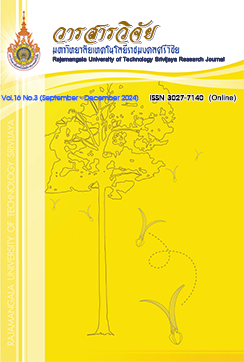Effect of Fiber Alignments on the Strength of Bulletproof Armor Plates Produced from Fiberglass Fabrics
Keywords:
bulletproof vest, armor plate, NIJ Standard, fiberglass fabricAbstract
This research aims to experimentally investigate the impact of fiber orientation on the strength of bulletproof armor made from composite materials, using fiberglass fabrics as reinforcement encased in polyester resin. The fiber orientation of the woven fiberglass sheets was arranged in two configurations: aligned at 0 degrees and alternately arranged at 45 degrees. Tensile and impact tests revealed that armor with fibers arranged at 45 degrees exhibited lower tensile strength but higher impact resistance compared to armor with fibers aligned at 0 degrees. Additionally, the armor plates were tested against .357 Magnum bullets fired from a distance of 5 meters, following the NIJ (National Institute of Justice) Standard-0101.06 for Level II body armor. The Back Face Signature (BFS) was also measured to assess the impact force on the back of the armor upon bullet impact. The results showed that the armor made from 30 layers of woven fiberglass sheets, both aligned at 0 degrees and alternately arranged at 45 degrees, successfully stopped the bullets without penetration. The average deformation depth of the backing material behind the armor was 8 mm and 6.33 mm, respectively, which is within the standard limits.
References
Amatariyakul, J. and Amatariyakul, W. 2016. Analysis of the Material for Making Bulletproof Vest Armor Efficient Level II. RMUTI Journal 9(2): 161-176. (in Thai)
Bagherpour, S. 2012. Fiber Reinforced Polyester Composites, pp. 135-166. In Saleh, H., eds. Polyester. IntechOpen, London.
Bangkokbiznews. 2020. Khon Kaen University shows a silk cocoon-based armor plate that can withstand M16 rifle bullets without penetration. Bangkokbiznews. Available Source: https://www.bangkokbiznews. com/tech/896119, June 5, 2024. (in Thai)
Chokchalerm, D. and Sriseubsai, W. 2017. Feasibility Study on The Development of Bulletproof Vest with Fish Scale by Dart Impact Method. Ladkrabang Engineering Journal 34(3): 9-14. (in Thai)
Jearanaisilawong, P. and Phungsara, B. 2020. Effects of Layer Arrangements on Bullet Protection Capability of Armor Plate. Defence Technology Academic Journal 2(6): 56-65. (in Thai)
Jongpairojcosit, N., Julniphitwong, A., Charoenpon, A., Lekthamrong, C., Hutacharoen, N. and Ridluan, A. 2020. The Analysis of Military Tire Concept using Sandwich Composite Structure made from Kevlar and Natural Rubber Using Finite Element Method and Experiment. Defence Technology Academic Journal 2(5): 90-99. (in Thai)
Kangwantrakool, S. 2010. Research Report on Improvement of Mechanical Properties of Alumina-Chromia with Zirconia Particles. University of Technology, Nakhon Ratchasima. (in Thai)
Khojitmet, S., Kiatprajak, J., Ruangrit, D. and Timsuwan, A. 2010. Development of Protective Body-Shield Against Explosive Fractions and Shrapnel of Small Bomb. Journal of Engineering RMUTT 1: 9-18. (in Thai)
National Institute of Justice. 2008. Ballistic Resistance of Body Armor: NIJ Standard-0101.06. U.S. Department of Justice, Washington, DC, USA.
Parsapratet, S., Amornsakchai, T., Sungnoo, S., Suppitaksakul, C., Kwankhao, B. and Chaiyalak, C. 2010. A Study of Producing Bullet Proof Vest from Man Made Fiber for Commercial Purposes. Journal of Engineering RMUTT 1: 19-27. (in Thai)
Prakash, A., Fasil, M. and Anandavalli, N. 2023. Ballistic performance of optimized light weight composite armour. Forces in Mechanics 12: 100216.
Pumkaew, M., Srikunwong, C. and Watanasriyakul, S. 2011. Development of Ceramic/ Fabric/ Metal Composite Armor System, AEC14, pp. nd. In The 25th Conference of Mechanical Engineering Network of Thailand. Thai Society of Mechanical Engineers, Kasetsart University, Bangkok. (in Thai)
Saicharoen, A., Tinprabath, P. and Chartpuk, P. 2022. Parameter Analysis that Affects the Ability to Resistance Penetration of Ammunition on the Aluminum Armor Surface Using Finite Element Method. RMUTP Research Journal 16(1): 177-191. (in Thai)
Sikarwar, R.S., Velmurugan, R. and Gupta, N.K. 2014. Influence of fiber orientation and thickness on the response of glass/epoxy composites subjected to impact loading. Composites Part B: Engineering 60: 627-636.
Sungkapun, T. 2013. Development and production of armor from aluminum matrix composite. Master Thesis of Engineering, Prince of Songkla University. (in Thai)
Wang, Z., Zhang, H., Dong, Y., Zhou, H. and Huang, G. 2023. Ballistic performance and protection mechanism of aramid fabric modified with polyethylene and graphene. International Journal of Mechanical Sciences 237: 107772.
Xianglin, H., Wei, Z., Yunfei, D. and Xiongwen, J. 2017. Experimental investigation on the ballistic resistance of polymer-aluminum laminated plates. International Journal of Impact Engineering 113: 212-221.
Zhu, Y., Ma, J., Fan, Z., Wen, Y., Xu, C. and Xia, M. 2024. Ballistic impact performance and blunt injury assessment of ceramic/UHMWPE laminate composite body armor. Journal of Materials Research and Technology 29: 1703-1728.
Downloads
Published
How to Cite
Issue
Section
License
Copyright (c) 2024 Rajamangala University of Technology Srivijaya Research Journal

This work is licensed under a Creative Commons Attribution-NonCommercial-NoDerivatives 4.0 International License.
The content and information in the article published in Journal of Rajamangala University of Technology Srivijaya It is the opinion and responsibility of the author of the article. The editorial journals do not need to agree. Or share any responsibility.







